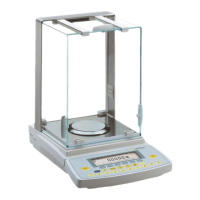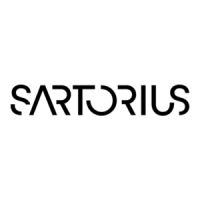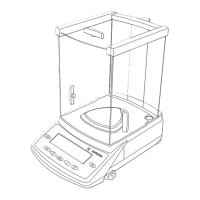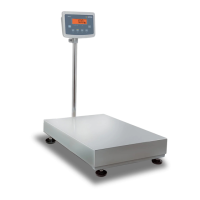Do you have a question about the Sartorius la series and is the answer not in the manual?
Describes the balance operation via display unit keys.
Explains the current function of soft keys indicated on the display.
Details the nine sections of the display for measured and calculated values.
Provides guidance on choosing a suitable location for balance setup.
Explains the process of conditioning a balance to room temperature after temperature changes.
Details the order of placing components for analytical draft shield chambers.
Details safety notes regarding the AC adapter and FCC compliance for radiated energy.
Details leveling procedures using the front feet for balances up to 12 kg.
Explains how to display, input, or change user data and block access with a password.
Lists functions like toggling weight units, counting, and density determination.
Includes checkweighing and time-controlled functions.
Covers totalizing, formulation, and statistics.
Lists categories like Interface, Print in weighing mode, Extra functions, and Reset menu.
Details data record configuration, output items, and automatic printout conditions.
Guides on viewing FlexPrint information, including print file names and software IDs.
Describes the fundamental weighing function, its features, and factory settings.
Explains how to release external calibration and its implications for verification.
Describes the process and sequence of internal calibration and adjustment.
Details the automatic calibration and adjustment function, its prompts, and settings.
Guides on performing the reproTEST function to determine balance reproducibility.
Explains switching between two weight units using a soft key.
Describes balance configuration, reference sample quantity, and piece weight calculation.
Details reference percentage, display options, and toggling between modes.
Describes manual/automatic start, subweighing operations, and toggling between weight and calculated values.
Explains compensating for over-poured components, transaction counter, and toggling displays.
Describes storing equations, toggling displays, operators, and equation length.
Describes methods for density determination (buoyancy, displacement, pycnometer) and liquid choices.
Details configuration for long-term storage, automatic initialization, target values, and limits.
Details time-controlled activation, functions like acoustic signal, and print options.
Describes totalizing weight and calculated values, memory storage, and printout options.
Details adding weight values, simultaneous storage, memory capacity, and printout options.
Describes storing weight/calculated values, simultaneous storage, and printout options.
Explains storing current weight as tare or entering preset tare values.
Details storing up to 4 IDs, defining names/values, and character limits.
Allows loading weight/calculation results from App 1 or 2 into App 3.
Details storing up to 300 data records, creating, storing, deleting, and searching for them.
Explains assigning functions to keys like CF for deleting input and applications.
Covers configuring display options like background color and digit size.
Details automatic printout settings for initialization values and line formats.
Explains activating FlexPrint for custom printouts using label formats and print instruction files.
Explains blocking access to settings and ID code input by assigning a password.
Provides detailed pin assignments for the interface connector and remote universal switch.
Details the nine sections of the display and information displayed.
Details information shown on the measured value line, including current weight and calculated values.
Shows the current weight unit and designations for other values like "pcs".
Explains symbols for different applications, print jobs, and ISO/GLP printouts.
Configures data records for Sartorius printers to meet legal metrology standards.
Describes printing with data ID codes and configuring line formats for applications.
Explains automatic printing based on display updates, stability, and operating status.
Explains printing weighing condition parameters before and after a series.
Guides on storing and printing calibration/adjustment procedures on request.
Lists factory default settings for interface parameters like transmission rate and handshake.
Explains outputting values with or without data ID codes and character configurations.
Explains connecting a computer to send commands via the interface port.
Explains data communication parameters for error-free transmission between balance and device.
Provides a detailed list of pin functions for the interface connector.
Details settings for application selection, program index, interface, and print modes.
Lists error codes, their causes, and corresponding solutions.
Provides instructions for cleaning the balance safely, avoiding liquid entry and using mild detergents.
Advises when safe operation is no longer warranted and whom to contact for service.
Provides a diagram and list of parts for LA Series balances with round glass draft shields.
Explains the function of keys like On/off, Setup, Config, App, Info, Menu, Input, and Function Keys.
Provides general specifications for AC power, frequency, ambient temperature, and selectable units.
Lists model-specific specifications like readability, weighing capacity, and tare range.
Details model-specific Type, Accuracy Class, Interval, Capacity, and Tare Range for verified models.
Lists the order number and features of the data printer.
Lists order number and features, including battery level indicator and recharge time.
Discusses Directive 90/384/EEC concerning non-automatic weighing instruments and EC type-approval.
States that Sartorius technicians are authorized to perform verification and inspection.
Explains the descriptive plate marked with CE.
Describes the balance operation via display unit keys.
Explains the current function of soft keys indicated on the display.
Details the nine sections of the display for measured and calculated values.
Provides guidance on choosing a suitable location for balance setup.
Explains the process of conditioning a balance to room temperature after temperature changes.
Details the order of placing components for analytical draft shield chambers.
Details safety notes regarding the AC adapter and FCC compliance for radiated energy.
Details leveling procedures using the front feet for balances up to 12 kg.
Explains how to display, input, or change user data and block access with a password.
Lists functions like toggling weight units, counting, and density determination.
Includes checkweighing and time-controlled functions.
Covers totalizing, formulation, and statistics.
Lists categories like Interface, Print in weighing mode, Extra functions, and Reset menu.
Details data record configuration, output items, and automatic printout conditions.
Guides on viewing FlexPrint information, including print file names and software IDs.
Describes the fundamental weighing function, its features, and factory settings.
Explains how to release external calibration and its implications for verification.
Describes the process and sequence of internal calibration and adjustment.
Details the automatic calibration and adjustment function, its prompts, and settings.
Guides on performing the reproTEST function to determine balance reproducibility.
Explains switching between two weight units using a soft key.
Describes balance configuration, reference sample quantity, and piece weight calculation.
Details reference percentage, display options, and toggling between modes.
Describes manual/automatic start, subweighing operations, and toggling between weight and calculated values.
Explains compensating for over-poured components, transaction counter, and toggling displays.
Describes storing equations, toggling displays, operators, and equation length.
Describes methods for density determination (buoyancy, displacement, pycnometer) and liquid choices.
Details configuration for long-term storage, automatic initialization, target values, and limits.
Details time-controlled activation, functions like acoustic signal, and print options.
Describes totalizing weight and calculated values, memory storage, and printout options.
Details adding weight values, simultaneous storage, memory capacity, and printout options.
Describes storing weight/calculated values, simultaneous storage, and printout options.
Explains storing current weight as tare or entering preset tare values.
Details storing up to 4 IDs, defining names/values, and character limits.
Allows loading weight/calculation results from App 1 or 2 into App 3.
Details storing up to 300 data records, creating, storing, deleting, and searching for them.
Explains assigning functions to keys like CF for deleting input and applications.
Covers configuring display options like background color and digit size.
Details automatic printout settings for initialization values and line formats.
Explains activating FlexPrint for custom printouts using label formats and print instruction files.
Explains blocking access to settings and ID code input by assigning a password.
Provides detailed pin assignments for the interface connector and remote universal switch.
Details the nine sections of the display and information displayed.
Details information shown on the measured value line, including current weight and calculated values.
Shows the current weight unit and designations for other values like "pcs".
Explains symbols for different applications, print jobs, and ISO/GLP printouts.
Configures data records for Sartorius printers to meet legal metrology standards.
Describes printing with data ID codes and configuring line formats for applications.
Explains automatic printing based on display updates, stability, and operating status.
Explains printing weighing condition parameters before and after a series.
Guides on storing and printing calibration/adjustment procedures on request.
Lists factory default settings for interface parameters like transmission rate and handshake.
Explains outputting values with or without data ID codes and character configurations.
Explains connecting a computer to send commands via the interface port.
Explains data communication parameters for error-free transmission between balance and device.
Provides a detailed list of pin functions for the interface connector.
Details settings for application selection, program index, interface, and print modes.
Lists error codes, their causes, and corresponding solutions.
Provides instructions for cleaning the balance safely, avoiding liquid entry and using mild detergents.
Advises when safe operation is no longer warranted and whom to contact for service.
Provides a diagram and list of parts for LA Series balances with round glass draft shields.
Explains the function of keys like On/off, Setup, Config, App, Info, Menu, Input, and Function Keys.
Provides general specifications for AC power, frequency, ambient temperature, and selectable units.
Lists model-specific specifications like readability, weighing capacity, and tare range.
Details model-specific Type, Accuracy Class, Interval, Capacity, and Tare Range for verified models.
Lists the order number and features of the data printer.
Lists order number and features, including battery level indicator and recharge time.
Discusses Directive 90/384/EEC concerning non-automatic weighing instruments and EC type-approval.
States that Sartorius technicians are authorized to perform verification and inspection.
Explains the descriptive plate marked with CE.











